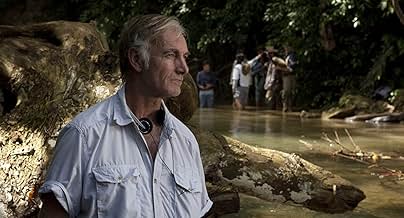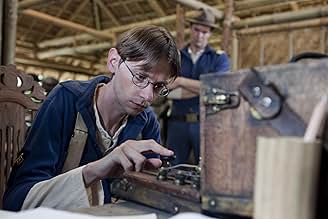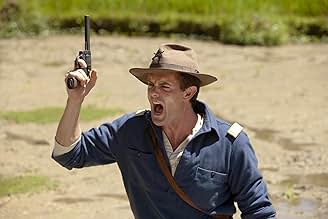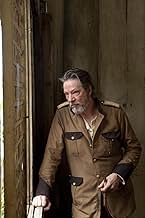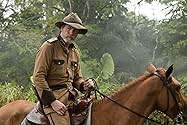Agrega una trama en tu idiomaA fictional account of events during the Philippine-American War.A fictional account of events during the Philippine-American War.A fictional account of events during the Philippine-American War.
- Dirección
- Guionista
- Elenco
- Premios
- 1 premio ganado y 9 nominaciones en total
Hoffman Cheng
- Chop-Chop
- (as Sai Ho Cheng)
Reymart Colestines
- Malpulgas
- (as Raymart Colestines)
Miguel Faustmann
- Captan Narvaez
- (as Miguel Faustman)
- Dirección
- Guionista
- Todo el elenco y el equipo
- Producción, taquilla y más en IMDbPro
Opiniones destacadas
John Sayles is the heart and soul of independent liberal filmmaking in the U.S. and he has triumphed once again with this small scale historical drama. Impeccably cast and masterfully written, Sayles only disappoints with his budgetary mandated use of digital cinematography. The sharp bright images of the film make one long for the warm celluloid grain of his frequent camerman Haskell Wexler. The Philippine/American War has hardly been touched by Hollywood except for THE REAL GLORY (1939), a flag waving whitewash of a controversial foreign incursion. Sayles is here to set the record straight and in this ambitious tale of a village invaded by naive American soldiers, he illuminates and entertains with his typically humanistic eye for people of all cultures, and the dark imperialistic inclinations of Western democracies.
Being an American, I have taken my fair share of history courses and studied many of the wars America has been in ever since it's formation and eventual birth in 1776. Just like everyone else, I leaned about Francis Scott Keys and the thirteen original colonies, but above all that, I also learned about the many events and politics which led to our independence. In school, they teach us about WWI and WWII as well as The Civil War, The revolution, the French and Indian War, etc etc. However, as history is so big and vast it well comes down to the perspective of how it is written and how one receives it.
John Sayles has taken on an incredible project. He has done something only one other filmmaker has done, and portrayed all his characters and events in a very different perspective. I say we learn about all the big wars and we always root for America, but Sayles brings to the big screen something that even today we hold in contention, which is the right for one country to invade another. The Philippine-American war is something any American can say they've never heard of (for the most part). It is a part of history America never looks back at, and there are reasons why. Sayles chooses to show America as the invader; the people who don't belong in the situation at hand (such as the War in Iraq), and it is a very intriguing perspective.
The story focuses on a small garrison of American soldiers who have taken post at a small baryo in the Philippines. We're introduced to a whole array of characters with very solid acting behind them all. There are great turns by DJ Qualls, Dane DeHann, Lucas Neff, and Brian Lee Franklin supported by the promising Garrett Dillahunt and always wonderful Chris Cooper. But above them all Joel Torre steals the show as the main character, Rafael, who is also what the title refers too.
Sayles masterfully crafts scene after scene and leads us through a captivating story. Throughout the film, Sayles makes us wonder, "Who is right?" or "What if both sides are right?", while there is a heavy wondering of God and if doing what God says justifies your actions. But then, what about personal choice or following your heart? Between Rafael and his rebellious son, there is a rift. His son helps the colonials, while Rafael is restricted to do what he wishes and must follow the American law that resides.
This is a film I recommend to all who enjoy the 'forgotten' parts of history. What Sayles has done here is another remarkable job of writing and directing while also serving another very unique perspective to the events which happened during the Philippine- American War. It's wonderful storytelling that leads to another well-crafted and haunting John Sayles-esque ending.
John Sayles has taken on an incredible project. He has done something only one other filmmaker has done, and portrayed all his characters and events in a very different perspective. I say we learn about all the big wars and we always root for America, but Sayles brings to the big screen something that even today we hold in contention, which is the right for one country to invade another. The Philippine-American war is something any American can say they've never heard of (for the most part). It is a part of history America never looks back at, and there are reasons why. Sayles chooses to show America as the invader; the people who don't belong in the situation at hand (such as the War in Iraq), and it is a very intriguing perspective.
The story focuses on a small garrison of American soldiers who have taken post at a small baryo in the Philippines. We're introduced to a whole array of characters with very solid acting behind them all. There are great turns by DJ Qualls, Dane DeHann, Lucas Neff, and Brian Lee Franklin supported by the promising Garrett Dillahunt and always wonderful Chris Cooper. But above them all Joel Torre steals the show as the main character, Rafael, who is also what the title refers too.
Sayles masterfully crafts scene after scene and leads us through a captivating story. Throughout the film, Sayles makes us wonder, "Who is right?" or "What if both sides are right?", while there is a heavy wondering of God and if doing what God says justifies your actions. But then, what about personal choice or following your heart? Between Rafael and his rebellious son, there is a rift. His son helps the colonials, while Rafael is restricted to do what he wishes and must follow the American law that resides.
This is a film I recommend to all who enjoy the 'forgotten' parts of history. What Sayles has done here is another remarkable job of writing and directing while also serving another very unique perspective to the events which happened during the Philippine- American War. It's wonderful storytelling that leads to another well-crafted and haunting John Sayles-esque ending.
10kaljic
Amigo is a fine film that should have gotten more traction at the box office. Its fictional portrayal of real historical events was a little too much, I think, for the average movie-goer in 2010, when it was released and when the Iraqi War in the Middle East was raging.
At the turn of the last century, Spain ceded the Philippines to the United States as a result of the Spanish-American War. This movie shows what the concession looked like on an everyday level. Spanish occupation of the Philippines had not been without incident, but the Spanish rule had been more geared to letting the local populations retain some element of self-rule. Self-rule went out the window when the Americans took over, symbolized by the conflict of the upper echelon office convincingly played by Chris Cooper, and everyone else.
Amigo has high production values, depicting fully formed, full dimensional characters. Some of the characters really stand out. Prominent is the priest, played by Yul Vasquez. The extent to which this character deliberately misinterprets whatever is being said by the local population which he secretly holds in such contempt to the Americans is truly breath-taking. It goes over the top at times, but not by much. The Filipino community is seen to be very close-knit but with volatile characters. The American foot soldiers are shown as young, inexperienced, uneducated rookies from the sticks, their lieutenant as a conflicted army officer trying to achieve a balance between American objectives and letting the local population rule themselves, and the commanding officer a hardened scrapper. Amigo shows the many many ways in which an invasion between two very different cultures can go wrong.
As far as I can tell Amigo has never been released on DVD, which is really too bad. It is a fine film which deserves to be seen.
At the turn of the last century, Spain ceded the Philippines to the United States as a result of the Spanish-American War. This movie shows what the concession looked like on an everyday level. Spanish occupation of the Philippines had not been without incident, but the Spanish rule had been more geared to letting the local populations retain some element of self-rule. Self-rule went out the window when the Americans took over, symbolized by the conflict of the upper echelon office convincingly played by Chris Cooper, and everyone else.
Amigo has high production values, depicting fully formed, full dimensional characters. Some of the characters really stand out. Prominent is the priest, played by Yul Vasquez. The extent to which this character deliberately misinterprets whatever is being said by the local population which he secretly holds in such contempt to the Americans is truly breath-taking. It goes over the top at times, but not by much. The Filipino community is seen to be very close-knit but with volatile characters. The American foot soldiers are shown as young, inexperienced, uneducated rookies from the sticks, their lieutenant as a conflicted army officer trying to achieve a balance between American objectives and letting the local population rule themselves, and the commanding officer a hardened scrapper. Amigo shows the many many ways in which an invasion between two very different cultures can go wrong.
As far as I can tell Amigo has never been released on DVD, which is really too bad. It is a fine film which deserves to be seen.
It is always difficult to tackle a war on film equally and fairly. Each side has its own interests to protect and uphold. Everyone regards the other as an enemy against them. There will be losses from all sides, direct and collateral. Yet, in the end, no one really wins. In "Amigo" by veteran director John Sayles, attempts to show all sides of a multi- dimensional conflict that was the Philippine-American War.
The film brings us back to the turn of the previous century, 1900, when Spain just ceded the Philippines to the USA. A group of young American soldiers under former architect Lt. Compton (Garrett Dillahunt) take control of a remote village called San Isidro. Trying to maintain some semblance of normalcy in his hostaged neighborhood was the barrio captain Rafael Dacanay (Joel Torre). There was also the Spanish friar Padre Hidalgo who continues his churchly mission, while interpreting for the Americans. On the other front, we have the Filipino revolutionaries who camp out in the jungle, led by Rafael's brother Simon (Ronnie Lazaro).
So we can see here a complicated web of intersecting conflicts that Sayles weaved for us. This was presented in a way that the audience can see the way each of these groups thought. The dialog went from English to Tagalog to Spanish and the occasional Chinese, so everything was seemingly told "in their own words." It will be very interesting how this movie will be viewed by audiences represented by the involved parties. While the story had a slow progression at the start, by the time it reached the climactic scenes, the suspense and tension was electric. The ending though was a bit awkward in my opinion. But definitely, the audience, especially the Filipinos, will identify with the conflicts within the tragic character of Rafael, who was caught between keeping the peace in his barrio, and his brother's cause for Filipino independence.
Joel Torre properly captures Rafael's essence and plays him with fervor and passion. Of course, with all the rather hammy acting of the unknown foreign actors behind them, the talent of Torre and the rest of the veteran Filipino cast (notably Rio Locsin as Rafael's religious wife) shone right through. The one known American actor Chris Cooper was in a one-dimensional villain role as a war freak American colonel. As the friar, Yul Vasquez seemed to be more American than Spanish, as he even had a forced Spanish accent. But I do congratulate him for his very good Tagalog speaking. I'm not very sure if it is an error, but I noted the Chinese characters (who were apparently there for comic relief) were speaking in Cantonese, but the predominant Chinese dialect in the Philippines should be Fukienese.
Overall though, this is a very good and thoughtful film about a war that had not been tackled before in Hollywood before. To his credit, American John Sayles directed this movie as if he was a true Filipino. He was successful in telling us his story from the Filipino point of view. He was even able to inject some vignettes of Filipino rural culture with scenes of a fiesta, a funeral and cockfighting. Filipinos should really go out and support this unique motion picture.
The film brings us back to the turn of the previous century, 1900, when Spain just ceded the Philippines to the USA. A group of young American soldiers under former architect Lt. Compton (Garrett Dillahunt) take control of a remote village called San Isidro. Trying to maintain some semblance of normalcy in his hostaged neighborhood was the barrio captain Rafael Dacanay (Joel Torre). There was also the Spanish friar Padre Hidalgo who continues his churchly mission, while interpreting for the Americans. On the other front, we have the Filipino revolutionaries who camp out in the jungle, led by Rafael's brother Simon (Ronnie Lazaro).
So we can see here a complicated web of intersecting conflicts that Sayles weaved for us. This was presented in a way that the audience can see the way each of these groups thought. The dialog went from English to Tagalog to Spanish and the occasional Chinese, so everything was seemingly told "in their own words." It will be very interesting how this movie will be viewed by audiences represented by the involved parties. While the story had a slow progression at the start, by the time it reached the climactic scenes, the suspense and tension was electric. The ending though was a bit awkward in my opinion. But definitely, the audience, especially the Filipinos, will identify with the conflicts within the tragic character of Rafael, who was caught between keeping the peace in his barrio, and his brother's cause for Filipino independence.
Joel Torre properly captures Rafael's essence and plays him with fervor and passion. Of course, with all the rather hammy acting of the unknown foreign actors behind them, the talent of Torre and the rest of the veteran Filipino cast (notably Rio Locsin as Rafael's religious wife) shone right through. The one known American actor Chris Cooper was in a one-dimensional villain role as a war freak American colonel. As the friar, Yul Vasquez seemed to be more American than Spanish, as he even had a forced Spanish accent. But I do congratulate him for his very good Tagalog speaking. I'm not very sure if it is an error, but I noted the Chinese characters (who were apparently there for comic relief) were speaking in Cantonese, but the predominant Chinese dialect in the Philippines should be Fukienese.
Overall though, this is a very good and thoughtful film about a war that had not been tackled before in Hollywood before. To his credit, American John Sayles directed this movie as if he was a true Filipino. He was successful in telling us his story from the Filipino point of view. He was even able to inject some vignettes of Filipino rural culture with scenes of a fiesta, a funeral and cockfighting. Filipinos should really go out and support this unique motion picture.
Without a doubt, a movie about this subject needed to be made. The parallels with America's wars with Vietnam and Iraq are endless, and the Philippines' history as the strategic spoils for foreign occupiers needs to be told. This movie did an okay job of depicting the arrogance of imperialism as well as the misery of those who want peace. However, I think the time limitation of a feature length movie hampers any real character development. The Americans' are haughty and racist caricatures, and the conflicts within the Filipino families are not as palpable as they should be. Also, important strategic events of the war are merely alluded to off-screen.
Throughout the whole movie, I couldn't help but feel the story would have been more suited to a TV-miniseries format. Such a format would have allowed ample time for character development and action scenes.
Throughout the whole movie, I couldn't help but feel the story would have been more suited to a TV-miniseries format. Such a format would have allowed ample time for character development and action scenes.
¿Sabías que…?
- TriviaBefore Amigo, the last movie about American forces in the Philippines was John Dahl-directed El gran escape (2005) which tackled World War II in the Philippines. Also in that movie was Bembol Roco who also appears in Amigo. Also in El gran escape (2005) was Cesar Montano who, just like Joel Torre, also plays Jose Rizal in José Rizal (1998).
- ConexionesFeatured in Bottomline: John Sayles (2011)
- Bandas sonorasKundiman of 1896 (Jocelynang Baliwag)
Traditional
Arranged and performed by Raul Manikan
Daring Music/Administered by Universal Music Corp./ASCAP
Selecciones populares
Inicia sesión para calificar y agrega a la lista de videos para obtener recomendaciones personalizadas
- How long is Amigo?Con tecnología de Alexa
Detalles
- Fecha de lanzamiento
- Países de origen
- Sitios oficiales
- Idiomas
- También se conoce como
- Baryo
- Locaciones de filmación
- Productoras
- Ver más créditos de la compañía en IMDbPro
Taquilla
- Presupuesto
- USD 1,500,000 (estimado)
- Total en EE. UU. y Canadá
- USD 184,705
- Fin de semana de estreno en EE. UU. y Canadá
- USD 37,324
- 21 ago 2011
- Total a nivel mundial
- USD 184,705
- Tiempo de ejecución2 horas 4 minutos
- Color
Contribuir a esta página
Sugiere una edición o agrega el contenido que falta

Principales brechas de datos
By what name was Amigo (2010) officially released in India in English?
Responda

